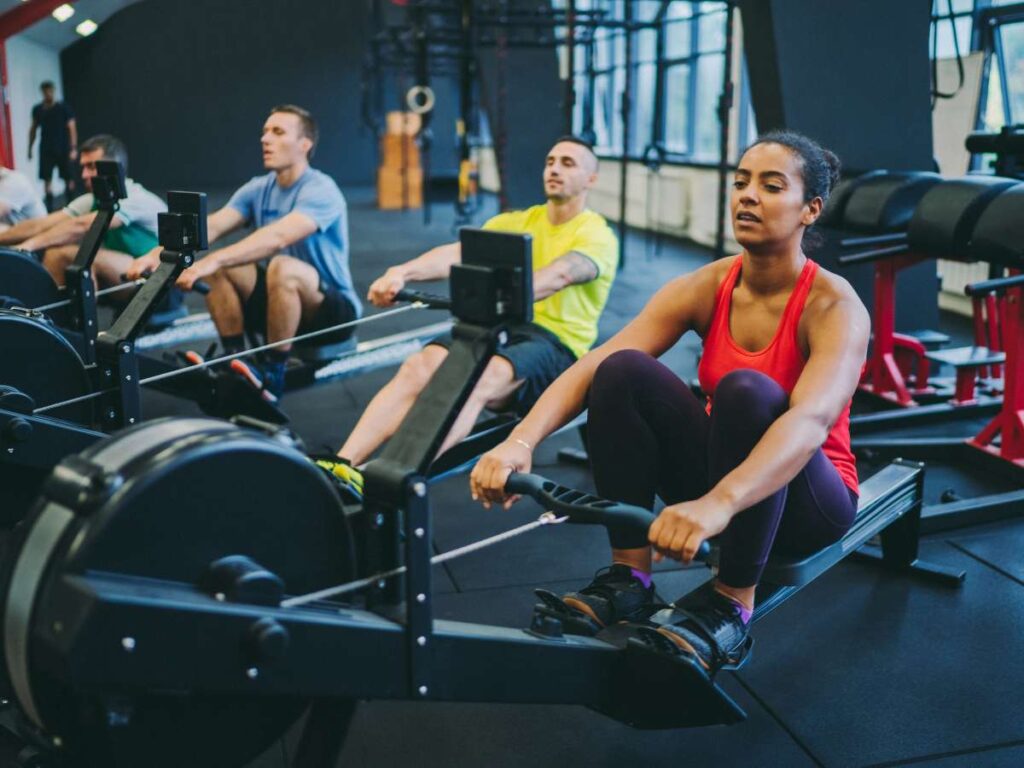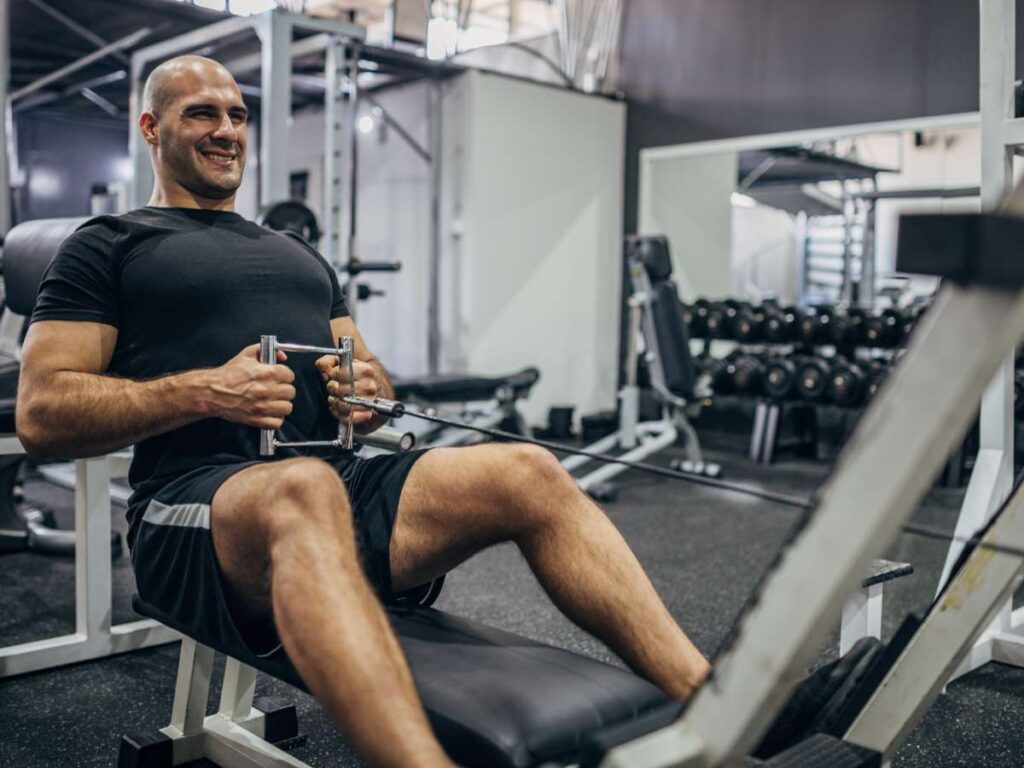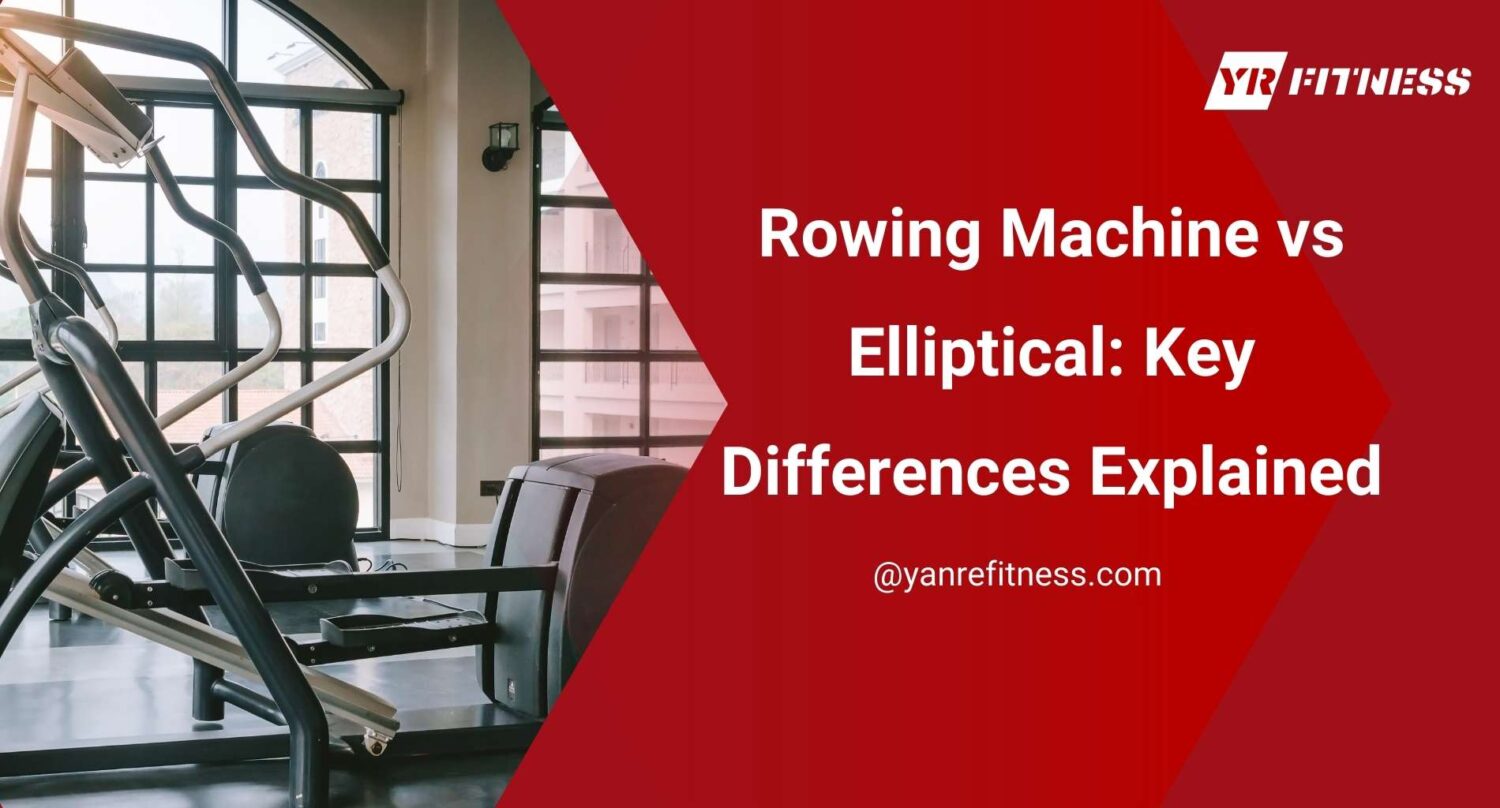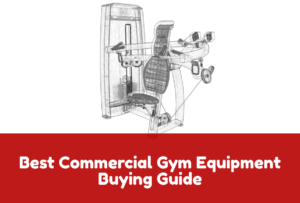A few years ago, I replaced two ellipticals with rowing machines.
Why?
Because fewer members were using them. I watch how members move. I clean the sweat off the gear. I ask for feedback. That’s how I learn what’s actually helping people. And what’s just taking up space.
If you’re asking yourself, “Which one is better for my gym?” I’ve been there. This article is for you.
You’ll see how both machines perform in real gym use how they feel to members, what they target, and what outcomes they deliver.
By the end, you’ll know which one is a better fit for your floor space.
Let’s dive in!
1. What Is a Rowing Machine?
My first rowing machine came from YR Fitness. I didn’t expect it to be a hit. But within weeks, it became one of the most-used machines in the gym. Members lined up for it—especially those looking for full-body cardio without added strain.
Rowing machines mimic the motion of rowing a boat. Users drive with their legs, engage their core, and finish with a pull through the upper body. It’s one fluid movement that works multiple muscle groups at once.
That’s a rare combination—especially valuable in commercial fitness settings.
Core Features
Most commercial rowers offer:
- Multi-Muscle Activation: Engages legs, core, back, and upper body
- Low Joint Stress: Suitable for older members or those with mobility issues
- Compact Design: Many models fold or store vertically to save floor space
- Adjustable Intensity: Resistance can be changed to match different user levels
- Performance Tracking: Onboard monitors typically track time, distance, pace, and stroke rate
Ideal Users in a Gym Setting
Rowing machines work well for:
- Functional fitness zones
- HIIT or bootcamp programs
- Members needing low-impact cardio options
- Gyms with space limitations but high demand for versatile equipment
They’re also a good fit for seasonal programming or recovery-focused plans. One machine can serve multiple roles across different programs.

2. What Is an Elliptical?
I have a member in her late 50s who swears by the elliptical. She’s not into heavy lifting. Doesn’t like treadmills. But she shows up three times a week—and the elliptical is always her go-to.
Machines like this work well for members who want cardio without joint pain. The motion is smooth. No pounding. Feet stay on the pedals, and hands move with the upper handles. It mimics walking, climbing, or running but with less strain.
Core Features
Most commercial elliptical machines include:
- Low-Impact Movement: No heel strike, reducing stress on knees and hips
- Dual-Action Design: Arms and legs move together to raise heart rate
- Variable Resistance: Users can adjust difficulty to match fitness levels
- Incline Options: Some models offer incline to better target glutes and thighs
- Built-In Consoles: Track time, pace, heart rate, and calories burned
Even mid-range models now come with touchscreens, preset programs, and Bluetooth. But what matters most—at least in my gym—is how easy the screen is to read.
If members don’t need help figuring it out, they’ll use it more. And that keeps the equipment in rotation.
Ideal Users in a Gym Setting
Ellipticals serve a wide range of users:
- Members focused on low-impact cardio
- Beginners who prefer simple, steady-state training
- Clients recovering from injury or surgery
- Individuals who want a full-body option without coordination-heavy movement
They also work well for warm-up zones or quiet cardio areas.
If you’re offering cardio solutions for mixed user groups, the elliptical is a strong fit—versatile, familiar, and easy to maintain.
3. Workout Effectiveness
I hear this question a lot from new members and even other gym owners:
“Which machine delivers better results?”
After running both on the floor and seeing how different members respond, I’ve had time to observe real differences—especially in calorie burn, muscle engagement, and how each fits into a training plan.
Calorie Burn
Rowing machines tend to burn more calories in less time. That’s because they engage more muscle groups at once and raise heart rate quickly.
Ellipticals offer a steady burn.The movement is smoother and easier to sustain for longer sessions, but generally less intense.
Muscle Engagement
Rowers activate nearly 85% of the body with each stroke.
- Lower body drives the push
- Core keeps the posture tight
- Upper body finishes the pull
This makes every rep more efficient—especially useful for clients short on time.
Ellipticals target both arms and legs, but with less resistance. It’s effective for light conditioning, not muscle development.
Training Applications
- HIIT (High-Intensity Interval Training): Rowers work well in fast-paced intervals. The quick effort changes push the heart rate fast and make recovery periods count.
- Full-Body Endurance: Longer rows build strength and cardio together. Ideal for group classes or personal training blocks.
- Strength-Cardio Fusion: Rowers pair well with weight circuits. You can alternate between cardio and strength without leaving the station.
- Warm-Ups: Ellipticals are smooth and joint-friendly. They help your members ease into movement without adding stress.
- LISS (Low-Intensity Steady State) Cardio: Good for long sessions at a consistent pace. Members can stay in a steady zone without overexertion.
- Rehab or Joint Recovery: The motion is easy on the knees and hips. It’s a solid choice for older clients or post-injury users.

4. Demographic & User Suitability
Before investing in new equipment, it’s important to ask who the machine is best suited for. Some equipment is more accessible to beginners, while others demand more coordination or fitness experience. Understanding the strengths of each machine helps you match them to your member base and training programs.
Beginner to Advanced Users
Ellipticals are intuitive and easy to use. Most members can step on and start moving without needing instruction. The upright posture and natural stride make it familiar, especially for those used to walking or climbing stairs. This makes the elliptical ideal for first-time gym members, general fitness users, and facilities with limited staff for equipment demos.
On the other hand, rowing machines require more guidance at the start. While the movement seems simple, proper rowing involves a specific sequence—leg drive, core engagement, and pulling through the arms. Without correct form, users may not get the intended benefits. That said, once members learn how to row effectively, it becomes a high-performance option suitable for intermediate and advanced users.
Rehab and Low-Impact Users
Ellipticals are better suited for users with joint issues or those recovering from injury. The continuous foot contact with the pedals reduces pressure on the knees and hips. The upright design also provides balance and stability, which is especially important for older adults or those regaining strength. These features make ellipticals a strong option for rehab programs or low-impact cardio zones.
Rowing machines also offer low-impact motion, but the seated position and need for core control can be limiting for some users in recovery. Without proper technique, they may overuse the lower back or struggle with balance at the end of each stroke.
Athletes or Performance Clients
Rowing machines are better suited for performance-focused users. They engage a larger number of muscle groups and support higher-intensity training methods. Athletes and advanced members can use rowers for power-building intervals, endurance work, or mixed-modality training like strength-cardio fusion. They’re also a favorite in sports conditioning and competitive training programs where output and progression tracking matter.
Ellipticals can still be used for longer cardio sessions, but they don’t offer the same resistance or muscular load as rowing. For members looking to push limits or improve athletic performance, rowing machines are the more effective tool.

5. Space & Installation Considerations
One thing I’ve learned over time—how a machine fits in your space is just as important as how it performs.
I once ordered two great machines that ended up crowding our walkways and blocking traffic flow during peak hours. It was a simple oversight, but it reminded me how much layout affects daily operations.
Let’s break down what you should consider when placing rowers and ellipticals on your gym floor.
Footprint and Storage
Rowing machines typically have a long frame—most measure between 8 and 9 feet in length. This makes them better suited for areas where lengthwise space is available. Some models do fold upright for easier storage, which can be useful in smaller training rooms or when you need to free up space between classes.
Ellipticals have a more compact length, but they require more width and overhead space. Their moving handlebars and upright design need extra clearance from walls, mirrors, or nearby machines. If space is limited on the sides or above, they can feel cramped.
Installation Requirements
Rowers are typically plug-free. Assemble them, roll them into place, and that’s it. I’ve always liked this about them—no searching for outlets or dealing with extension cords.
Ellipticals, on the other hand, often have motorized resistance and digital consoles. That means they need nearby power access. It’s something you want to plan before rearranging a full cardio section, or you’ll end up stuck shifting things around later.
Noise Levels
Noise is another important factor, especially in shared or quiet zones. Rowers, particularly those using air or water resistance, can be loud during use. The sound of the fan or flywheel is noticeable and may not be ideal in upstairs facilities or low-noise training areas.
Ellipticals, by comparison, are much quieter. Their smooth, continuous motion makes them better suited for rehab areas, personal training zones, or facilities with strict noise control.
6. Maintenance Requirements
I used to think equipment maintenance was just about wiping things down and moving on.
But after a couple of unexpected breakdowns during peak hours—followed by member complaints and refund requests—I realized how much routine care really matters.
Keeping machines in good shape isn’t just about function. It affects trust, traffic flow, and the member experience.
Let’s break down what you need to know.
Rowing Machines
Rowers are pretty simple compared to other cardio machines. They don’t require a power outlet and have fewer electronics. But that doesn’t mean they’re hands-off.
Here’s what I’ve learned to stay ahead:
- Wipe the rails and seat at least once a week
- Check for loose foot straps or worn handles
- Lubricate the chain or cord if it starts feeling sticky
- For water rowers, add tablets to keep the tank clean
Ellipticals
Ellipticals need a little more care. They’ve got motors, screens, and more moving parts—so you’ll want to stay on top of them.
Some key checks I’ve added to my routine:
- Clean tracks and rollers to stop squeaking or sticking
- Test console buttons regularly—those wear out faster than you’d think
- Check power cords for damage or wear
- Keep an eye on the arms and pedals—they can loosen over time
I once had an elliptical arm come loose mid-workout. No one was hurt, but it shook the member’s confidence—and mine too.
7. Cost and ROI
Some machines were cheaper but barely used. Others cost more but stayed busy all day.
That’s when I started looking at value over time—not just what I paid upfront.
Here’s a simple side-by-side to help you compare rowing machines and ellipticals.
Category | Rowing Machine | Elliptical |
Price Range | $800 – $2,500 | $1,200 – $4,000 |
Power Requirements | No electricity needed | Usually requires outlet for motor and console |
Maintenance Needs | Low (mostly mechanical upkeep) | Moderate (electronics, moving arms, software) |
User Base | Intermediate to advanced; HIIT, strength-cardio users | Beginners, seniors, general cardio users |
Usage Flexibility | Great for group classes, personal training | Good for warm-ups, steady cardio, recovery |
Durability | Long-lasting with proper upkeep | Also durable, but parts may need more service |
ROI Potential | High in performance and small group settings | High in volume-use areas and beginner zones |
If you match the machine to the right users and program, both can bring solid returns. The key is thinking beyond the sticker price and looking at how often—and how well—it’ll be used.
I also recommend purchasing equipment from a reputable manufacturer like YR Fitness, which guarantees long-term value, reliable after-sales support, and durable construction built for commercial use.
A well-made machine doesn’t just last longer—it performs better, gets used more, and makes your investment worthwhile.
8. Tips For Choosing Between Rowing Machine and Elliptical
Making the right equipment choice depends on more than just features or price. It’s about understanding how each machine fits into your space, programming, and member needs.
Here are practical tips to guide your decision:
Tip#1 Understand Your Member Demographics
Start by evaluating who uses your facility most often. If your gym serves beginners, older adults, or those in recovery, the elliptical is likely a better fit due to its ease of use and low-impact design. If your members are focused on high-intensity workouts or performance training, rowing machines will offer more value.
Tip#2 Evaluate Floor Space and Layout
Rowing machines take up longer but are easier to store vertically when not in use. Ellipticals have a taller, wider footprint and need additional clearance on the sides and above. Measure your space before committing to either option.
Tip#3 Factor in Maintenance and Staff Capacity
Rowers are mechanically simpler and require less upkeep.Ellipticals have more moving parts and electronic systems, which may require more frequent checks and service. If your team is limited or your maintenance schedule is already tight, rowers may be easier to manage long term.
Tip#4 Match the Equipment to Your Training Offerings
If your gym offers group classes, circuit training, or high-intensity intervals, rowers provide a versatile and challenging option—especially when paired with free weights or machines to support multi-modality programming.
Ellipticals are ideal for steady-state cardio, recovery zones, or warm-up areas where low-impact movement is a priority.
Conclusion
Every gym has space for cardio. But not every gym makes the most of it.
We broke down what rowers do best. We showed where ellipticals shine. You now know the difference and how each one fits real gym life.
Your floor is valuable. So is your members’ time.
Don’t let the wrong machine take up both. Start building a smarter gym today.
Contact YR Fitness to choose the right machine for your space!
Related articles:






